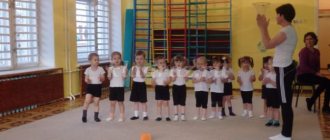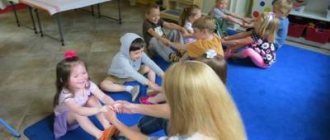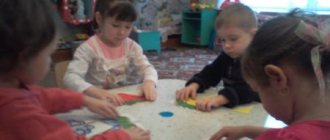Plans and outlines of physical education classes for pupils of the first junior group
| Final part | ||
| Low-intensity outdoor game “Find where it’s hidden”: the players close their eyes, and the teacher hides a small object on the playground. At a signal, children open their eyes, calmly walk around the playground and look for an object. The one who found it picks it up, the game repeats again | 2 times | The teacher tells the children what exactly he hid (toy, ball, cube). You can't run during the game |
Outline No. 3
Transport
Location:
outdoor playground or gym.
Form:
integrated (with the educational area “Child and Society”).
Tasks:
Increase the functional stability of the vestibular apparatus;
To form an idea of transport in the immediate environment and its types; teach walking on a gymnastic bench and jumping from a height;
Stimulate and maintain interest in transport.
Equipment:
chairs according to the number of children, 5–6 large gymnastic sticks, 2 cords, gymnastic bench, mat, pictures of transport (bus, plane, train)
| Content | Dosage | Organizational and methodological instructions |
| Introductory part | ||
| Types of transport 1. The teacher sequentially shows the children pictures of a bus, plane, train and clarifies how it can be called in one word (transport). Children use pictures to determine what the vehicle has in common (wheels, steering wheel, motor). The teacher invites children to go on a trip using different types of transport | 4 min | |
| We're going by bus 2. Outdoor game “Bus”: in the center of the hall there is a bus built from chairs. It has a seat for the driver (the first chair) and a lounge for passengers (all other chairs, arranged in twos). The teacher sits in the driver's seat, and the children take the passenger chairs and remember their place. At stops, passengers get off the bus and perform variations of walking (on their toes, in a squat), and then take their seats again in the cabin | 2–3 times | The bus rides to the music, the driver holds a hoop in his hands - the “steering wheel” After stops, passengers take only their seats. To improve orientation in space, you can use chairs of different colors or mark identical chairs with colored stickers. At the end of the game, the bus arrives at the airport and the teacher invites the children to travel further by plane |
| We're flying by plane 3. Outdoor game “Planes”, the players – “planes” – sit on “airfields” – chairs. At the command “Planes start engines!” children make circular movements with their arms bent in front of their chest and pronounce the sound | 3 times | Chairs are arranged around the site in random order You only need to land at your airfield |
Card file of physical education activities during a walk in the 1st junior group.
Complexes of physical education classes
on a walk.
1st junior group.
Complex No. 1 (September).
Program objectives: Teach children to walk and run in small groups, following the teacher. Develop the ability to act on a signal. Learn to walk between two lines (limited area), maintaining balance. Practice jumping in place on two legs.
- Walking and running in small groups in a straight direction. Game “Let’s go visit” - the children are walking, “it’s raining!” run to their houses (2 times).
- -Walking between two lines in a column (drawn on the asphalt)
-P/n “Run to me” (the teacher stands on the opposite side of the children and says the words “run all of you to me”) is repeated 3-4 times.
-exercise “Bunny”. 10-15 jumps alternating with walking in place (3-4 times)
Complex No. 2 (September).
Program objectives: Teach children to walk and run as a whole group according to the symbols following the teacher, consolidate the ability to jump in place on two legs. Learn to maintain starting positions during game exercises.
- Walking and running with the whole group following the teacher along the path.
- Game exercises.
- “Show your palms.” I.p. standing with your feet hip-width apart, your arms at your sides. Raise your hands forward, say “here”, return to IP (5p)
- “Show your knees.” I.p. standing with your feet shoulder-width apart, hands on your belt. Bend forward and place your palms on your knees, say “here”, return to IP (5p)
— Jumping on 2 legs in place, alternating with walking in place (2p)
P/n “Catch the ball.” The teacher rolls the ball in one direction, the children catch up with it, then in the other direction. (2p)
- Walking in a flock behind the teacher, he may have a ball in his hands.
Complex No. 3 (October).
Program objectives: To familiarize children with walking and running in a column behind the teacher. Learn to do the exercises simultaneously with the teacher: sit down, clap in front of you. Develop the ability to respond to a signal and run in all directions.
- Walking and running in a column.
- Exercises:
- “Clap” I.p. standing, arms down along the body. Bring your hands forward, clap in front of you, return to IP (5p)
- “Squats” I.p. too, hands on the belt. Sit down, touch your knees with your palms, stand up, return to the standing position (6 times).
- “Jumping” on 2 legs in place, alternating with walking (2p)
P/i “Sparrows and a cat” (Children stand in circles, a child-cat squats to the side, in response to the words “the sparrows have flown” the children spread their arms to the sides “flapping their wings” and run in all directions, the cat wakes up and shouts “meow”, runs after the children, and the children run away into the houses) (2p)
- Walking in a column behind the teacher one at a time.
Complex No. 4 (October).
Program objectives: Teach children to walk and run in circles after the teacher. Learn to maintain stable balance while performing exercises. Develop spatial orientation and respond to signals.
- Walking and running in circles.
- Exercises:
- “Birds.” I. p. standing, legs slightly apart, hands behind the back, 1- arms to the sides, wave them: “chick-chirp”, 2- return to I. p. (5p)
- “The clock is striking.” I.p. legs apart, hands on the belt. 1-tilt right - left, say “boom”, 2-p. (6 r)
-P/n “Find your house.” Children stand behind the line, at the words “let’s go for a walk” the children run away in different directions, at the signal “home” the children run to the “house” (2p)
-P/i “My funny ringing ball” (2p)
3. Walking in a column one at a time, the teacher may have a flag in his hands.
Complex No. 5 (November).
Program objectives: Teach children to stop when the teacher gives a signal while walking and running. Develop coordination of movements. Learn to run after each other without overtaking, and quickly respond to a signal in the next place.
- Walking and running in a column one at a time, stopping at the teacher’s signal.
- Exercises:
- “Mill” I.p. feet width apart, arms along the body. Swing both arms back and forth, return to IP (5–6 r)
- “Kolobok” I.p. the same, hands on the belt. Sit down, clasp your knees with your hands, stand up, etc. (5-6p)
-P/i “Train” (children line up in a column one at a time, the first in the column is a steam locomotive, the rest are carriages, when moving slowly they say “chu-chu-chu”, “the train is approaching the station”, the children stop) (2p) .
-P/i “Hen and Chicks” (2p)
3. Low mobility game “Guess who’s screaming?” (the teacher imitates the sound of the animal with his voice, and the children guess and depict the habits of this animal).
Complex No. 6 (November).
Program objectives: Strengthen the ability to walk and run in a circle. Develop balance and coordination of movements, the ability to quickly respond to a signal.
- Walking and running in circles.
- Exercises:
- “Tumbler.” I.p. standing, hands on the belt, rock back and forth, rest after 4 swings. (5r)
- “Jumping” on two legs, alternating with walking in place. (5p)
-P/i “Run to the flag” (the teacher holds a flag in his hands, at the signal “Run to the flag” the children run to the teacher.) (2-3p)
-P/n “Bear” (child is a bear, the children come up to him and say the words “Bear, bear, why have you been sleeping for so long? Bear, bear, why are you snoring so much? Bear, bear, bear, get up, bear, bear with us play!” The bear wakes up and says, “Why did you sing songs to me, why did you wake me up?” The children run away, the bear catches up) (2-3r).
3. Walking in a column behind the teacher.
Complex No. 7 (December).
Program objectives: Exercise children in walking and running in a column, changing walking and running according to symbols. Develop the ability to jump on two legs while moving forward. Develop response to signals, develop balance and correct posture when walking
- Walking and running in a column one at a time.
- -Walking and running between two lines (in line, children walk along one path and run along the other) (2p).
-Jumping on two legs moving forward.
-P/i “Mice in the pantry” (mice children sleep in holes, the teacher cat falls asleep, the mice run into the pantry, “gnaw crackers” when going out for a walk, the cat wakes up, screams “meow”, the mice run into the pantry.)
(2-3r)
- Sedentary game "Bubble". Slow walking around the kindergarten.
Complex No. 8 (December).
Program tasks: Practice walking in a column one at a time, performing tasks as directed by the teacher, jumping according to symbols, walking along a winding path, developing attention.
- Walking in a column one at a time, completing the teacher’s tasks, running in all directions. (Children walk in a column one after another, complete tasks - we walk like “butterflies”, “bunnies”, then run in all directions) 2 times.
- -Walking along a winding path one after another (3p).
-Jumping on a flat path.
-P/i “Tram” (the teacher has flags of two colors in his hands, children stand one after another pretending to be a tram, run to the “green flag”, stand to the “red” flag) (3p).
3. Sedentary game “In an even circle.”
Complex No. 9 (January).
Program tasks: Continue to teach walking and running in all directions, squatting, maintaining balance, jumping, moving forward. Teach quick changes of movements.
1. Walking and running randomly.
2.Exercises:
- “Birds” I. p. feet width apart, hands below. Raise your arms to the sides, lower them, return to IP (6p).
- “Squats” I. p. too, hands on the belt. Sit down, return to standing position (4p)
-P/i “Along a level path” (“Along a level path, along a level path our feet walk: One, two, one, two. Over the pebbles, over the pebbles... Into the hole - bang!”... the children walk, to the words “on pebbles" - they jump on two legs, moving forward, to the words “into the hole” - they squat down, “they got out of the hole” - the children get up.) (2p)
-P/i “Shaggy Dog” (2p).
3. Walking in a column, one at a time, behind the teacher.
Complex No. 10 (January).
Program tasks: Learn to walk in pairs, strengthen running in all directions, practice jumping. Develop coordination of movements during squats, a clear change of movements (jumping - walking). Continue learning to respond to a signal. Develop imagination.
- Walking in pairs, running in all directions.
- Exercises:
- “Swing” I.p. legs slightly apart, arms down. Swing your arms forward and back, slightly springing your legs. When swinging we say “uh” (6p)
- “Ball” Jumping in place, alternating with walking (5 jumps 3 times).
-P/i “At the bear in the forest” (2-3r).
-P/i “Sparrows and the cat” (Sparrows are children, the cat is the driver, to the words “sparrows fly” the children run, flapping their wings, the cat wakes up “meow”, the children run away to the teacher’s house) (2-3r)
3. Sedentary game “Find a toy” (the teacher hides the toy in advance, the children walk around the playground and look for it).
Complex No. 11 (February).
Program tasks: strengthen walking one at a time, completing tasks, exercise running, jumping, develop physical qualities.
- Walking and running in a column one at a time.
- Exercises:
- “Start the engine” I.p. feet width apart, arms in front of the chest, elbows bent, fingers clenched into fists. Circular movements of the arms in front of the chest, one arm rotating around the other. (5r)
- “Hedgehog” I.p. legs slightly apart, hands behind back. Sit down, clasp your knees with your hands, stand up, put your hands behind your back, return to standing position. (5r)
— Jumping on two legs, alternating with walking (5 jumps of 3p each)
-P/i “Shaggy Dog” (2р)
3. Walking in a column, one at a time, around the kindergarten.
Complex No. 12 (February).
Software tasks. Teach children to respond to the teacher’s signal. In outdoor games, reinforce the rules. Develop jumping ability and accuracy.
- "Merry sparrows and horses." Walking in a column, at the signal of the “sparrow” - the children stop and flap their wings. At the “horses” signal, the children gallop straight ahead.
- Game “Roll and Knock Down” Children stand in a line, they have balls, you need to knock down the pins with balls (2 times).
Game "Find your color". Children run scattered around the playground, at the teacher’s signal, they run up to their color flag (hoop)
- times).
- Game "Planes". Walking at a slow pace around the kindergarten.
Complex No. 13 (March).
Software tasks. Teach children to make movements with words. Reinforce walking on a limited surface.
- Game "We stomp our feet." Children make movements along with words.
We stomp our feet, we clap our hands, we nod our heads.
We raise our hands. We lower our hands, we give our hands.
And we run around and around and around.
- Exercise “We are clever guys.” Walking on a board, a limited surface, arms to the sides.
"From bump to bump." Jumping from hoop to hoop on 2 legs.
- Sedentary game “Bubble” (2 times). Walk at a slow pace behind the teacher.
Complex No. 14 (March).
Software tasks. Teach children to run between objects without touching them. Continue teaching children to jump on 2 legs, moving forward; roll the ball between objects.
- “Run, don’t hit me.” Walking and running between objects.
- Game "Roll the ball between objects." Roll the ball between cubes and objects.
Game "Jumping Bunnies". Children jump from one side of the playground to the other on 2 legs. Alternate with walking (2-4 times).
- Game "Carousel" (performed at a slow pace 2-3 times).
Complex No. 15 (April).
Software tasks. Continue to teach children to walk, stepping over blocks, maintaining balance; jump over a rope on 2 legs. Learn to hit the ball with 2 hands.
- Game "Even Step". Walking in a column one at a time, stepping over the cubes. Run after each other.
- “Throw the ball on the ground and catch it.” Hitting the ball on the ground with 2 hands
(10 times).
"Through the stream." Jumping on 2 legs over a rope. (5-6 times).
- Sedentary game “Pass the ball.” Passing the ball from hand to hand in a circle (try not to let the ball fall out of your hands).
Complex No. 16 (April).
Software tasks. Teach children to complete a task at a signal from the teacher. Develop reaction speed in children.
- Game "Starlings". Children are "starlings" running around the playground. At the signal, the children run into the “hoops” birdhouses (towards the cubes).
- Game “Cucumber, cucumber” (children go to the “mouse” and say the words: cucumber, cucumber, don’t go to that end, the “mouse” lives there and will bite off your tail). The “mouse” is catching up with the children.
Game "Brave Mice". Climb under the cord, hands on knees (height 40 cm).
- Sedentary game “On a level path.” Walking behind the teacher on a limited surface or along a cord.
Complex No. 17 (May).
Software tasks. Teach children to hit, toss, throw the ball.
Strengthen slow running in all directions. Develop coordination in children.
- Game "Through the Swamp". Walking, stepping over objects. Running between objects.
- Ball game:
- throwing up with 2 hands;
- hitting the ball on the ground with 2 hands;
-throwing a ball through a rope (objects) from behind the head with 2 hands.
3. Sedentary game "Cars". Simulate the motion of driving cars scattered across the site without touching each other.
Complex No. 18 (May).
Software tasks. Continue to teach children to accurately follow the teacher’s commands; roll the hoop in a straight line; develop the eye and precision of movements.
- Game "Find yourself a match." Children walk around the playground; at the teacher’s signal, the children quickly look for a mate (you can use flags of different colors).
- Game "Roll the Hoop". Children stand in a line, the hoop stands on its edge, the children must roll the hoop as far as possible.
Game “Bear the Bear in the Forest” (2-3 times).
- Game "Complete the task." Children perform the task at the command of the teacher.


